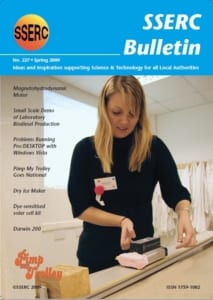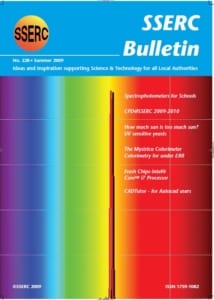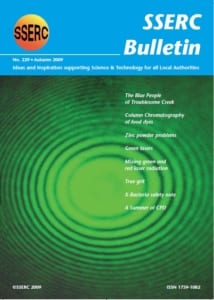Following on from the homopolar motor described earlier, and inspired by an article by Abdul-Razzaq et al in Physics Education magazine, we describe an electric motor where the moving conductor is a liquid. The study of the movement of electrically conducting fluids is known as magnetohydrodynamics.
CAD-CAM – Problems with Windows Vista
The CAD/CAM in Schools programme, launched in June 1999, was implemented to ensure that all secondary schools in the UK have access to CAD/CAM. As a result of this initiative, Pro/DESKTOP a feature-based solid modeller software for Windows is now used in over 75% of UK secondary school Technology Departments.While Pro/DESKTOP was not designed for use with Windows Vista, it is possible to enable successful running under Vista. One of the most noticeable problems with Pro/DESKTOP and Vista is an immediate error message when trying to create an extrusion.
Small Scale Demo of Biodiesel Production
We have developed a method which allows students to make biodiesel for themselves quickly and simply. By keeping the scale small and doing the reaction quickly, the exposure to risk is much reduced. The biodiesel can be collected by either leaving the mixture to settle overnight, or by separating them using a centrifuge. The overnight method produces a purer product, but the use of a centrifuge means the entire process can be carried out in about half an hour.
Highlighting some resources to celebrate the 200th anniversary of the birth of Charles Darwin, this year.
SSERC’s physics activity on crash testing and crumple zones has attracted attention from the Times Educational Supplement, the Institute of Physics (IoP) and Road Safety Scotland. Now schools throughout the country can try this activity for themselves.
Dye Sensitised Solar Kit – Part 1
Dye sensitised solar cells (DSSCs) or Grätzel cells use a dye which directly converts the energy of sunlight into electrical energy using a process which is similar, in some aspects, to photosynthesis. Various dyes can be used in DSSCs which will have different photon trapping efficiencies, and this could form the basis of interesting student investigations linking biology, chemistry and physics to the aspirations of Curriculum for Excellence at Level 4. It also lends itself to AH Chemistry projects.
We have recently had a query about one of these not working. It transpired that the problem could well have been with the type of gas cylinder and not the attachment. Dry ice making attachments will only work with a particular type of CO2 cylinder. The cylinder must be fitted with a dip tube (this is often referred to as a ‘siphon type’ cylinder). This allows liquid CO2 to be siphoned from the bottom of the cylinder.
Colorimeters are desirable, occasionally essential, pieces of equipment for use in secondary chemistry and biology laboratory work. A major factor which limits the availability of colorimeters is cost. In this report we explore the design, reliability and scope of a new colorimeter marketed by Mystrica (see www.Mystrica.com).
We have previously reported on the work of the three-year project Support for Science Education in Scotland through CPD. Through this collaborative, Scottish Government funded project, SSERC and its partners offer experiential professional development opportunities to a range of groups who are key to providing a stimulating learning environment for school science. As we approach the end of the first year of the work of The Project it is worth taking stock of what we have achieved.
How much sun is too much? – UV sensitive yeasts
Over the last decade the incidence of skin cancer in Scotland (specifically malignant melanoma) has increased by a staggering 30%. A significant factor, particularly amongst younger people, is the use of sun-beds to achieve that healthy glow. It is therefore important to ensure that our young people are informed of the dangers of too much sun or the over-use of sun-beds. We describe a practical activity which can be used to underpin this message.
Intel® have recently launched its Core™ i7 Processor. As a result of changes in the architecture of the processor chip, the benefits are faster, intelligent multi-task applications. Within School Technology departments, obvious benefits will be when working with your favourite CAD/CAM/CAE packages,
Spectrophotometers for Schools
Here we review two spectrophotometers suitable for use in school science labs. Both connect to computers via the USB connection. The models we looked at were the Red Tide from Ocean Optics and the SpectroVis from Vernier.
Information about the upcoming SSERC Summer Schools CPD opportunities.
As the number of available abrasive types have increased over recent years, the selection and purchase of suitable abrasives has now become a difficult task. Today the term ‘sandpaper’ is often used to cover any type of abrasive material, of which there are many. This article seeks to help guide your choice.
Column Chromatography of Food Dyes
Many pupils are familiar with the technique of paper chromatography in its various forms either with inks or food dyes, but few are aware of column chromatography. This method uses a length of soda glass tubing approximately 20 cm long, or a glass Pasteur pipette as the column. Both columns give very good separation.
Blue People of Troublesome Creek
Ramette introduced the phrase ‘exocharmic reactions’ to describe reactions and demonstrations, particularly those in chemistry, which fascinate, allure or delight the observer. Despite their undoubted value as pedagogic aids, collections of demonstrations for use in biology teaching are not widely available. One might argue, therefore, that we need some exocharmic demonstrations for biology. Whilst the example that follows is not new, a minor tweak to the standard experimental conditions used means that we have produced a ‘nice’ demonstration to support delivery of the biology curriculum.
People have been having problems wiht their zinc powder – we investigate.
Health and Safety
X-Bacteria – additional safety advice
X-Bacteria is a practical kit, funded by The Wellcome Trust, which forms part of the Survival Rivals series of activities to celebrate Darwin Year. These excellent activities, which are available free to schools, enable pupils to examine different aspects of evolution.






